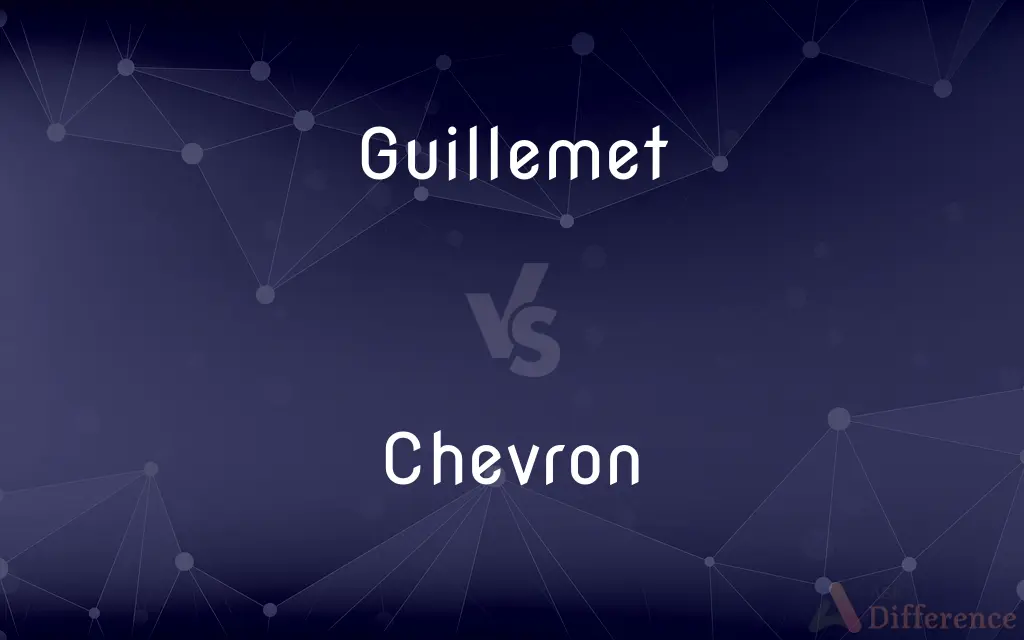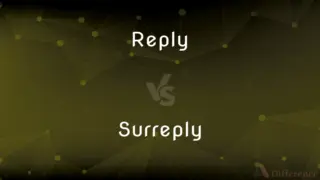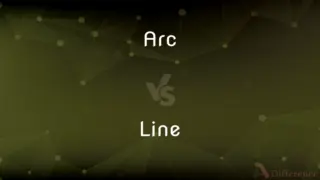Guillemet vs. Chevron — What's the Difference?
Edited by Tayyaba Rehman — By Urooj Arif — Updated on April 5, 2024
Guillemets are punctuation marks used in various languages for quoting, while chevrons are V-shaped symbols used in mathematics, military insignia, and more.

Difference Between Guillemet and Chevron
Table of Contents
ADVERTISEMENT
Key Differences
Guillemets, also known as angle quotes, are punctuation marks used primarily in non-English languages to denote direct speech or to highlight particular segments of text. They appear in pairs, pointing inward («like this») for opening quotes and outward (»like this«) for closing quotes, depending on the language. On the other hand, chevrons are characters or symbols shaped like a V or an inverted V, used across different fields with varying meanings. In mathematics and computer science, they are used to denote vectors or to encapsulate elements. In military or heraldry contexts, chevrons are insignia used to indicate rank or length of service.
Guillemets are an integral part of the typesetting and punctuation systems in languages such as French, Italian, and Russian, where they serve to enclose speech and quotations. They provide a clear distinction between the quoted material and the rest of the text, ensuring that readers can easily navigate through complex narratives. Conversely, chevrons play a crucial role in denoting relationships or hierarchies within mathematical sets, computer code, and organizational structures. Their usage is more symbolic, representing direction, connection, or rank rather than linguistic context.
In typography, guillemets are specific to the cultural and linguistic norms of certain languages, adhering to the stylistic and grammatical rules of those languages. This usage underscores the diversity of punctuation practices around the world and the importance of context in written communication. Chevrons, however, are utilized more for their graphical shape and directional properties, transcending linguistic barriers to find a place in various domains including mathematics, where they are essential in vector notation, and graphic design, where they contribute to visual hierarchy and emphasis.
While guillemets are part of the standard punctuation in specific language systems, requiring users to understand their proper application within those languages, chevrons are more universally recognized symbols whose meanings are derived from their context rather than from grammatical rules. This universality allows chevrons to be applied across a broad spectrum of disciplines without the need for linguistic adaptation.
Despite their distinct uses, both guillemets and chevrons enrich the visual and semantic landscape of communication. Guillemets enhance the clarity and structure of written language, especially in dialogue and quotations, while chevrons add a layer of meaning and organization in fields ranging from mathematics to heraldry, demonstrating the versatility and expressive power of symbols.
ADVERTISEMENT
Comparison Chart
Shape
Double angle quotation marks (« »)
V-shaped symbol (^ or <)
Usage
Quotation marks in certain languages
Denote vectors, ranks, or hierarchies
Representation
Inward or outward pointing
Upward, downward, or sideways
Linguistic Association
Used in French, Italian, Russian, etc.
No linguistic association
Fields of Application
Typography, language
Mathematics, military, design
Compare with Definitions
Guillemet
Used as quotation marks in several languages.
In French, guillemets enclose direct speech.
Chevron
Represents vectors or sets in mathematics.
The vector is denoted as ⟨a, b⟩.
Guillemet
Differentiate between levels of quotation.
‹Secondary quotes› are often nested within «primary quotes».
Chevron
Indicates direction or navigation in design.
Chevrons are used in signs to direct traffic flow.
Guillemet
Appear as double angle brackets pointing inward or outward.
«This is an example».
Chevron
Symbolizes rank or hierarchy in military insignia.
A sergeant might wear three chevrons.
Guillemet
Integral to the typesetting systems of specific languages.
Guillemets are standard in Russian typography.
Chevron
Used in heraldry and logos for symbolic representation.
A chevron appears in the coat of arms.
Guillemet
Adapt to the directionality of the text.
In Hebrew, guillemets are used in reverse order.
Chevron
Serves as a decorative element in graphic design.
Chevrons add visual interest to a layout.
Guillemet
Guillemets (, also UK: , US: , French: [ɡijəmɛ]) are a pair of punctuation marks in the form of sideways double chevrons, « and », used as quotation marks in a number of languages. In some of these languages "single" guillemets, ‹ and ›, are used for a quotation inside another quotation.
Chevron
A badge or insignia consisting of stripes meeting at an angle, worn on the sleeve of a military or police uniform to indicate rank, merit, or length of service.
Guillemet
Either of a pair of punctuation marks («) or (») used in some languages, such as French and Russian, to mark the beginning and end of a quotation.
Chevron
(Heraldry) A device shaped like an inverted V.
Guillemet
Either of the punctuation marks « or », used in several languages to indicate passages of speech. Similar to typical quotation marks used in the English language, such as " (and formerly also “ and ”).
Chevron
A V-shaped pattern, especially a kind of fret used in architecture.
Guillemet
A quotation mark.
Chevron
A V-shaped pattern; used in architecture, and as an insignia of military or police rank, on the sleeve.
Chevron
(heraldry) A wide inverted V placed on a shield.
Chevron
One of the V-shaped markings on the surface of roads used to indicate minimum distances between vehicles.
Chevron
A guillemet, either of the punctuation marks “«” or “»”, used in several languages to indicate passages of speech. Similar to typical quotation marks used in the English language such as ““” and “””.
Chevron
An angle bracket, either used as a typographic or a scientific symbol.
Chevron
(informal) A háček, a diacritical mark that may resemble an inverted circumflex.
Chevron
To form or be formed into chevrons
Chevron
One of the nine honorable ordinaries, consisting of two broad bands of the width of the bar, issuing, respectively from the dexter and sinister bases of the field and conjoined at its center.
Chevron
A distinguishing mark, above the elbow, on the sleeve of a non-commissioned officer's coat.
Chevron
A zigzag molding, or group of moldings, common in Norman architecture.
Chevron
V-shaped sleeve badge indicating military rank and service;
They earned their stripes in Kuwait
Chevron
An inverted V-shaped charge
Common Curiosities
What is a chevron?
A chevron is a V-shaped symbol used in various contexts, including mathematics, military, and design, to represent vectors, ranks, or decorative elements.
How do the uses of guillemets and chevrons differ?
Guillemets are used as part of linguistic punctuation systems, while chevrons have versatile applications across mathematics, military insignia, and design.
How are guillemets used in different languages?
Guillemets are used to enclose speech or quotations, with their orientation (pointing inwards or outwards) varying by language.
What are guillemets?
Guillemets are punctuation marks used as quotation marks in several languages, appearing as double angle brackets.
Can chevrons be used in typography?
Yes, chevrons are used in typography but mainly for decorative purposes or to indicate direction, not for punctuation.
Are guillemets part of English punctuation?
No, guillemets are not typically part of English punctuation; English uses straight or curly quotation marks instead.
Are guillemets and chevrons interchangeable?
No, guillemets and chevrons serve different purposes and are not interchangeable.
Do chevrons have any specific meaning in heraldry?
In heraldry, chevrons symbolize protection and often represent builders or others who have accomplished some work of faithful service.
Do guillemets have a standard orientation?
The orientation of guillemets varies by language; they can point inwards or outwards depending on the language's conventions.
Is the use of guillemets or chevrons more widespread?
Chevrons have a more widespread use due to their applicability in various fields beyond language, such as mathematics and design.
Can chevrons be used to indicate directions?
Yes, chevrons are often used to indicate directions in signs and graphical interfaces.
Are there different types of chevrons?
Yes, chevrons can vary in design and orientation, including being inverted or displayed horizontally, to convey different meanings or functions.
Can chevrons indicate rank in any organization?
Yes, chevrons are commonly used to indicate rank or level of service in military and similar organizations.
How are guillemets typed on a keyboard?
Typing guillemets usually requires the use of special key combinations or character codes, as they are not standard on most keyboards.
Can guillemets be used for anything other than quotations?
Guillemets are primarily used for quotations and speech; their use beyond this is limited and highly language-specific.
Share Your Discovery

Previous Comparison
Reply vs. Surreply
Next Comparison
Arc vs. LineAuthor Spotlight
Written by
Urooj ArifUrooj is a skilled content writer at Ask Difference, known for her exceptional ability to simplify complex topics into engaging and informative content. With a passion for research and a flair for clear, concise writing, she consistently delivers articles that resonate with our diverse audience.
Edited by
Tayyaba RehmanTayyaba Rehman is a distinguished writer, currently serving as a primary contributor to askdifference.com. As a researcher in semantics and etymology, Tayyaba's passion for the complexity of languages and their distinctions has found a perfect home on the platform. Tayyaba delves into the intricacies of language, distinguishing between commonly confused words and phrases, thereby providing clarity for readers worldwide.
















































